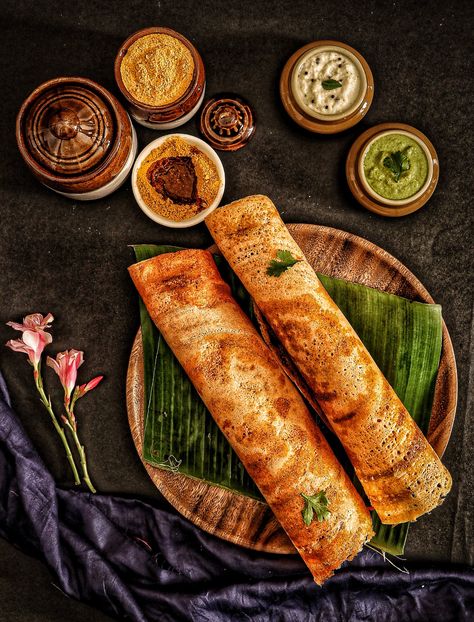
Masala Dosa, a crispy and savoury South Indian delicacy, has earned its place as one of the most loved dishes across the globe. Its delightful combination of a thin, golden-brown dosa paired with spicy potato filling and tangy chutneys makes it a breakfast favorite and an irresistible snack at any time of the day. In this blog, we delve into everything you need to know about Masala Dosa—from its origins to its preparation, health benefits, and tips for making it at home.
A Brief History of Masala Dosa
The origins of Masala Dosa trace back to the southern states of India, particularly Karnataka. The dosa itself, a type of fermented rice and lentil crepe, has been a staple in South Indian cuisine for centuries. The “masala” component, referring to the spiced potato filling, is said to have been a later addition, enhancing the dish’s flavor and popularity. Over the years, Masala Dosa has become a culinary ambassador for Indian food, with countless variations served in restaurants worldwide.
Ingredients for the Perfect Masala Dosa
For the Dosa Batter:
- 2 cups of rice (preferably parboiled or idli rice)
- 1 cup of split black gram (urad dal)
- ¼ teaspoon fenugreek seeds
- Water (for soaking and grinding)
- Salt to taste
For the Potato Filling (Masala):
- 3 medium-sized boiled potatoes
- 1 medium onion, finely chopped
- 1 green chili, finely chopped
- 1 teaspoon mustard seeds
- 1 teaspoon turmeric powder
- 6-8 curry leaves
- ½ teaspoon grated ginger
- 2 tablespoons oil or ghee
- Salt to taste
For Serving:
- Coconut chutney
- Tomato chutney
- Sambar (lentil-based vegetable stew)
Step-by-Step Preparation of Masala Dosa
1. Preparing the Batter:
- Wash the rice, urad dal, and fenugreek seeds thoroughly and soak them in water for 4-6 hours.
- Grind the soaked ingredients into a smooth batter using a blender, adding water gradually.
- Transfer the batter into a large bowl, add salt, and let it ferment overnight or for 8-12 hours in a warm place.
2. Preparing the Potato Filling:
- Heat oil in a pan and add mustard seeds. Let them splutter.
- Add curry leaves, ginger, green chilies, and onions. Sauté until the onions turn translucent.
- Mash the boiled potatoes and add them to the pan along with turmeric and salt. Mix well.
- Cook for 2-3 minutes and set the filling aside.
3. Making the Dosa:
- Heat a non-stick or cast-iron griddle and lightly grease it with oil.
- Pour a ladleful of batter onto the griddle and spread it in a circular motion to form a thin crepe.
- Drizzle a few drops of oil around the edges and cook until the dosa turns golden and crispy.
- Place a portion of the potato filling in the center of the dosa, fold it, and serve hot.
Serving Suggestions
Masala Dosa is best enjoyed with an array of accompaniments. Coconut chutney, made with freshly grated coconut, green chilies, and a hint of tamarind, adds a creamy and tangy flavor. Tomato chutney offers a sweet and spicy contrast, while sambar brings a hearty and wholesome element to the dish. A steaming cup of filter coffee completes the South Indian breakfast experience.
Health Benefits of Masala Dosa
- Rich in Nutrients: The dosa batter, made from rice and urad dal, is a good source of carbohydrates and proteins. The fermentation process also enhances its nutritional value by increasing the bioavailability of vitamins.
- Low in Fat: When cooked with minimal oil, Masala Dosa is a low-fat option that can fit into a balanced diet.
- High in Fiber: The potato filling, when combined with vegetables like peas or carrots, can boost fiber intake, aiding digestion.
- Gluten-Free: Naturally gluten-free, Masala Dosa is an excellent choice for those with gluten intolerance.
Tips for Making the Perfect Masala Dosa at Home
- Achieve the Right Fermentation: Ensure the batter ferments properly by keeping it in a warm place. In colder climates, you can place it inside an oven with the light on.
- Consistency of the Batter: The batter should be of pouring consistency, neither too thick nor too runny.
- Even Spreading: Use the back of a ladle to spread the batter evenly and quickly on the hot griddle.
- Crispiness: To make the dosa extra crispy, cook it on medium-high heat and avoid flipping it.
- Experiment with Fillings: While the classic potato filling is a favorite, you can experiment with paneer, cheese, or mixed vegetables for a unique twist.
Regional Variations of Masala Dosa
- Mysore Masala Dosa: Known for its spicy red chutney spread on the dosa before adding the potato filling.
- Rava Masala Dosa: Made with semolina instead of fermented batter, offering a different texture and taste.
- Paper Dosa: An ultra-thin and crispy variation that is larger in size.
- Set Dosa: Smaller, softer dosas served in sets of two or three with a mild potato curry.
Facebook – https://www.facebook.com/TastyBites3s/

One Response